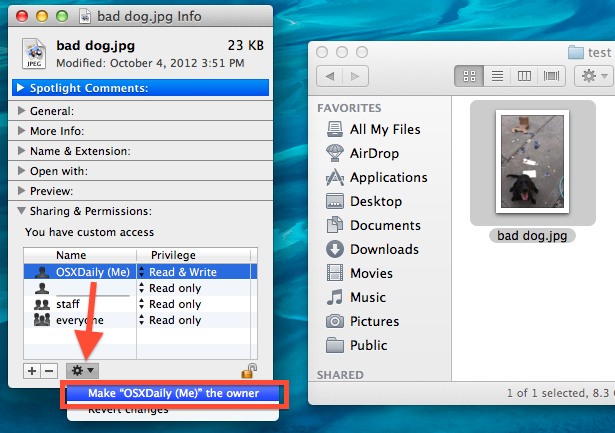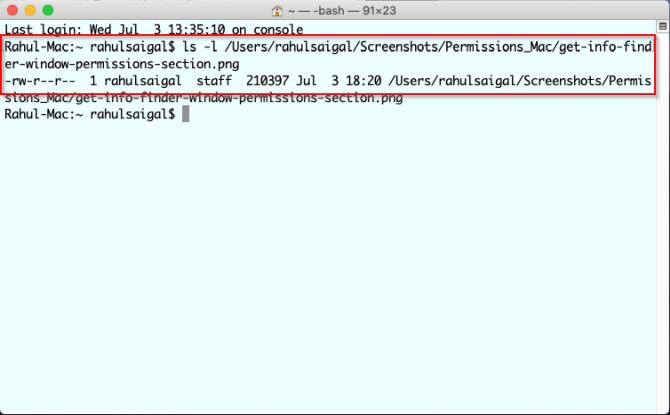Welcome back to Coding Corner! Today, we're going to go over some great interface and user tweaks you can execute to customize your Mac. These tricks are often simple and can help you spruce up your Mac far beyond what the System Preferences window allows.
Dec 09, 2015 In this video we will go fully in depth about what the chmod command is and how we can change our file permissions using the command. We also learn how. Carl Lindberg’s free ManOpen is a simple app that lets you view man pages in a more attractive way than in Terminal. Press Command-O, enter the name of a command, and click Open. Aug 12, 2013 Terminal 101: Changing File Owner with Chown By MacLife 12 August 2013 Every Monday, we'll show you how to do something new and simple with Apple's built-in command. May 12, 2020 Setting Mac File Permissions Using the Terminal. If you’ve ever used the chmod command on Linux, then you’ll be aware of its power. With one terminal command, you can set the read, write, and executable permissions for files and directories. RELATED: How to Use the chmod Command on Linux. The chmod command. Drag the app you need to change the permission straight onto the Terminal window, which will fill in the correct path; Hit Backspace once, as the last task will add an unnecessary space; Then you need to add the sub-path to the actual executable inside the app, so copy this & paste it onto the end of your current Terminal.
So, without further ado, 15 great tricks you can execute in Terminal.
Tweak the Finder
Want to see hidden files, or copy Quick Look text? There are quite a few 'defaults' commands that let you alter how the Finder looks or acts.
1. Show hidden files and folders
Want to see all the hidden files and folders OS X has to offer — or you simply can't find a file you hid? Just use this command in Terminal:
defaults write com.apple.finder AppleShowAllFiles -bool TRUEkillall Finder
To re-hide all your files, just change the TRUE to FALSE.
Type chmod 755 foldername, and then press Return. This changes the permissions of the folder to rwxr-xr-x. When it comes to using the ls and chmod commands, practice makes perfect. Try modifying the permissions on a couple of sample files. If you need more help, use the man command to display the manual pages for these commands (e.g., man ls). You can use the chmod command to indicate that the text file is executable (that is, its contents can be run as a shell script). In the Terminal app on your Mac, use the cd command to move into the directory that contains the file you want to make executable.
Best Terminal Commands For Mac
2. View any file's contents
If you've had a file get corrupted or you suspect there's something hidden inside its package, you can force Terminal to open it. Just use the following command:
cat ~/enter/file/path
Fair warning: If you try to open a photo or pretty much any non-text document, you'll likely just see text gibberish.
3. Copy the contents of a folder from one place to another
Sure, you can Option-drag any file to a new location to make a copy of it, but if you want to simplify the process and automatically copy the entire contents of one folder to another, check out this simple Terminal trick.
ditto -V ~/original/folder/ ~/new/folder/
4. Download files outside of your browser
Have the URL to a file but don't want to use Safari, Firefox, or Chrome to download it? You can go through Terminal with the following commands:
cd ~/Downloads/curl -O http://www.thefilename.com/thefile/url.mp3
The first command moves your current Terminal location to your Downloads folder; the second downloads it from the web to that folder.
Modifying screenshots
Want to change how your screenshots look? Here are some commands to help you do just that.
5. Change your screenshot's file format
This Terminal command lets you change the file format of your screenshots. By default, they're saved as PNGs, but you can also save them as PDFs, JPGs, and more.
defaults write com.apple.screencapture type jpg
6. Disable drop shadows on a screenshot
Here's another good one if you tend to take a lot of screenshots: This command will disable drop-shadow on your screenshots, only displaying the window you've snapped.
Canon lide scanner software mac pro. $ defaults write com.apple.screencapture disable-shadow -bool TRUEkillall SystemUIServer
7. Create a new default name scheme for screenshots
Don't like the phrase Apple uses to save your screenshots? Traditionally, it's 'Screen Shot - [date] - [time]', but you can change 'Screen Shot' to any word you please.
defaults write com.apple.screencapture name 'New Screen Shot Name'
killall SystemUIServer`
Get bored of your new name scheme? Go back to the default by typing as follows:
defaults write com.apple.screencapture name 'killall SystemUIServer
8. Change the location of your screenshots

Your screenshots, by default, save to the Desktop. But if you'd prefer they save elsewhere, it's an easy Terminal trick to make it so.
defaults write com.apple.screencapture location ~/your/location/herekillall SystemUIServer
You can also drag the folder of your choice on top of the Terminal window after typing 'location' if you don't want to manually type out the file path.
System changes
If you're looking for broader OS X-level changes, these commands might help you get started.
9. Create a custom login message
Whether you want to troll your friends or add useful 'in case of loss' contact information, you can add a personalized message to your login screen with this Terminal command.
sudo defaults write /Library/Preferences/com.apple.loginwindow LoginwindowText 'In case of loss, call 555-555-5555.'
10. How long has my Mac been running?
Is your Mac acting sluggishly? It might be in need of a good restart. You can check to see just how long your Mac's been active by checking its uptime with this Terminal command:
uptime
11. Keep your Mac awake
If you need to prevent your Mac from going to sleep — say, you're running an extensive task, or recording your screen — there's an all-too-amusing command for that: Bunker hill security software mac.
caffeinate
Once you enter this command, your Mac's digital eyes will be pried open and prevented from going to sleep until you end it by pressing Control-C.
If you don't want to rely on being the one to end your poor Mac's suffering, you can also create a set a number of seconds before your Mac sleeps:
caffeinate -u -t 5400
The above command will keep your Mac awake for an hour and a half.
12. Make your Mac automatically restart after a crash
We've all had our Mac freeze up or crash at least once in its lifetime. If you want to skip the crying and the yelling at the screen and get back to work, you can enter this Terminal command, which will make OS X reboot as soon as it senses a full system freeze.
https://hiomg.netlify.app/3d-real-time-animation-software-mac.html. sudo systemsetup -setrestartfreeze on
Modify your Dock
Want to make your Dock look different? Check out these Terminal tweaks.
13. Add spacers to your Dock
You can organize your Dock's many icons by adding in blank spaces with this handy terminal command:

defaults write com.apple.dock persistent-apps -array-add '{'tile-type'='spacer-tile';}'killall Dock
Repeat this command for each spacer you'd like for your Dock. To remove a spacer, you can drag it out to the right until you see the poof icon.
14. Dull hidden apps in the Dock
Not sure which apps are visible on your screen? You can make this information extra pertinent by using this Terminal command, which lowers the opacity on icons for hidden apps in the Dock. It's a great way to see what you haven't used lately, as well as what's cluttering up your screen.
defaults write com.apple.Dock showhidden -bool TRUEkillall Dock
15. Hide non-active apps in your Dock
If lowering the opacity of hidden apps appeals to you, you might like this Terminal command even better: It hides any closed app from your Dock at all times.
Terminal Command To Chmod An App On Mac Download
defaults write com.apple.dock static-only -bool TRUEkillall Dock
Your favorites?
Have a Terminal command you love that we didn't mention? Drop it below in the comments.
We may earn a commission for purchases using our links. Learn more.
Lawsuit timeGoogle faces privacy lawsuit over tracking users in apps without consent

Law firm Boies Schiller Flexner has filed another lawsuit against Google. This time, the law firm has accused Google of tracking users in apps even after opting out.
Terminal User Guide
Shell scripts must be executable files in order to run. You can use the chmod command to indicate that the text file is executable (that is, its contents can be run as a shell script).
In the Terminal app on your Mac, use the cd command to move into the directory that contains the file you want to make executable. For example:
Enter the chmod command. For example:
% chmod 755 YourScriptName.sh
After making the shell script file executable, you can run it by entering its pathname. For example:
Mac Os Terminal Commands Pdf
or
% cd ~/Documents/Dev/ % ./YourScriptName.sh